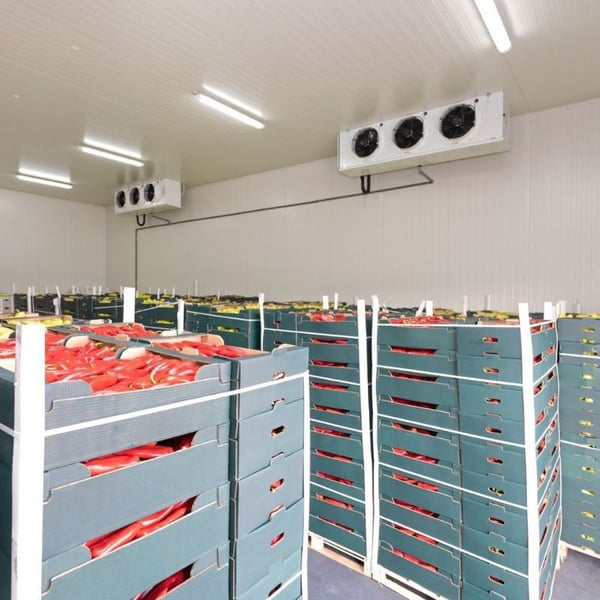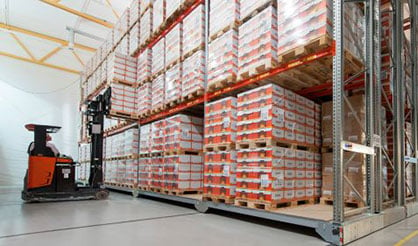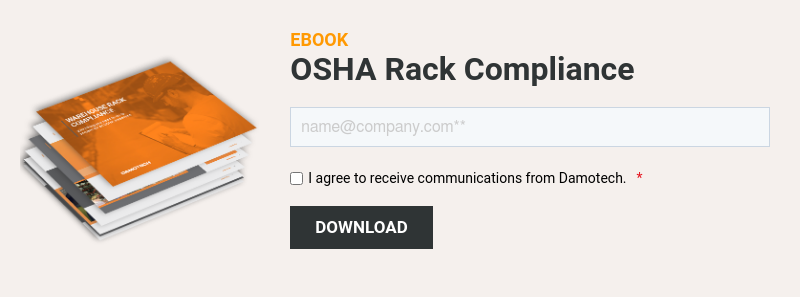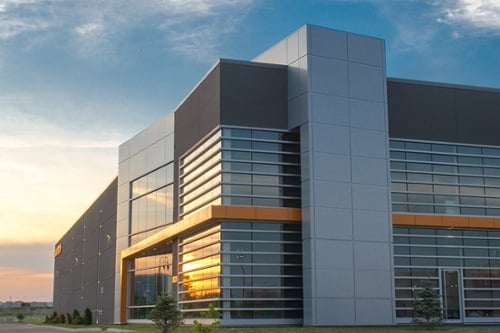In cold storage and food warehouses, rack damage isn’t a matter of if—it’s when. With forklifts zipping through aisles, condensation dripping, and inventory moving in and out the same day, your racks are constantly under pressure. Here’s how to stop damage before it costs you compliance, inventory, or injuries.
👉Take a look at the 5-Part Strategy to Prevent Rack Damage in the Food and Beverage Industry.

Photo: Cold storage warehouse. Inbound Logistics
Why Cold Storage and Food Warehousing Is Uniquely Prone to Rack Damage
Cold and fresh food warehouses—like those operated by Frito-Lay, Coca-Cola, SuperValu, Nestlé, Kroger, and PepsiCo—are high-velocity zones where forklifts never stop moving.
- Forklifts rush products like beer, dairy, and fresh produce out the same day they arrive.
- Narrow aisles and dense racking mean zero margin for driver error.
- Condensation from refrigeration systems reduces tire traction and visibility.
- Limited stacking space makes every pallet position critical.
- Drive-in racks are common, but extremely prone to rear-impact damage.
Did you know? In a typical 100,000 sq. ft. food & beverage warehouse, 10–15% of racking will have serious issues, and 3–5% must be unloaded immediately due to collapse risk.

The True Cost of Rack Damage in Food & Beverage Warehousing
- Lost inventory: Damaged racks = blocked SKUs = missed shipments.
- Injuries and compliance risk: Rack collapses trigger OSHA fines and injury lawsuits.
- Spoiled products: Damage can delay refrigeration flow or shift pallet positions, compromising safety.
- Disruption: Full rack replacements mean weeks of downtime and significant costs.
Common Rack Safety Failures in Refrigerated Warehouses & Fresh Food Storage
- Unreported Forklift Impacts: Especially in fresh food storage, where operators are incentivized for speed.
- Improvised or DIY Repairs: Fixing with zip ties, wood blocks, or duct tape is not only unsafe but also illegal.
- Overloaded or Reconfigured Racking Without Engineering Review: Disaster can strike when beam levels are changed without recalculating capacity.
- Improper Anchoring or Rusted Hardware: In freezers or high-humidity spaces.
- Corrosion and Ice Buildup: Rust weakens steel, and ice reduces rack baseplate stability.

Photo Credit: Dexion
What is cold storage racking?
Cold storage racking refers to pallet rack systems engineered for refrigerated warehouses or frozen environments. These systems withstand temperature fluctuations, high humidity, and aggressive forklift activity common in food and beverage warehousing. Cold storage racking must comply with ANSI MH16.1, be corrosion resistant, and support high-density layouts like drive-in or push-back racking.
Types of Food Warehousing and Their Rack Requirements
Understanding food warehouse types helps tailor racking and damage prevention strategies.
Fresh Food Warehouses
- Products: Produce, dairy, meat
- Requirements: Refrigeration, fast throughput
- Rack Impacts: High forklift movement, condensation
Frozen Food Warehouses
- Products: Ice cream, frozen meat
- Requirements: Deep freeze, insulated structures
- Rack Impacts: Steel contraction, brittle materials, slippery surfaces
Dry Food Warehouses
- Products: Grains, canned foods, pasta
- Requirements: Dry, clean storage
- Rack Impacts: Lower risk, but high stacking and turn rates
Beverage Warehouses (e.g., beer)
- Products: Bottled or canned drinks
- Requirements: Heavy pallets, accessibility
- Rack Impacts: Structural overloads from dense pallet weight
Summary: Rack Risk Matrix by Warehouse Type
| Warehouse Type | Common Risks | Recommended Rack Solution |
|---|---|---|
| Fresh Food | Speed, condensation | Galvanized uprights + base guards |
| Frozen Storage | Brittle steel, ice buildup | Powder-coated kits + seismic anchoring |
| Beverage Warehouse | Heavy pallets, impact loads | DAMO PRO + rear-impact guards |
📌 Racking systems must be engineered per warehouse type and local safety codes (ANSI MH16.1, RMI, OSHA).

What Every Food & Beverage Warehouse Operations Manager Should Know
Key responsibilities for rack safety and flow:
- Monitor for rack strikes during peak hours
- Ensure beams are secured with safety pins
- Rotate perishables using FIFO methodology
- Keep rack load plaques/labels visible and accurate
- Work with engineering teams to inspect racking at least annually
The 5-Part Strategy to Prevent Rack Damage in the Food and Beverage Industry
1. Perform Frequent Rack Inspections
- Train staff for weekly visual checks.
- Use Damotech’s rack inspection software for visual logs and compliance reporting.
- Get annual third-party engineering reviews.
- Do weekly visual checks by team leads.
2. Repair, Don’t Replace
- Why wait weeks for OEM lead times?
- Damotech’s rack repair kits (e.g., DAMO PRO) restore structural integrity without full teardown.
- Racks stay loaded during installation = no disruption.
- DAMO PRO’s Lifetime warranty vs. costly replacements.
3. Reinforce High-Traffic Zones with Protective Equipment
- Use DAMO FENCE and DAMO END GUARD in drive-in lanes and around refrigeration doors.
- Install DAMO BASE GUARD near transfer zones where rear-end impacts are frequent.
4. Foster a Forklift Safety Culture
- Use visual cues (floor tape, mirrors) in tight lanes.
- Slow zones near cold storage areas with slippery floors.
- Train drivers to report strikes immediately.
Stat: 60%+ of rack damage in fresh food warehouses is caused by human error.
5. Engineer for the Environment
- Use galvanized materials in freezers or fresh food environments.
- Never mix rack components from different manufacturers.
- Recalculate rack capacity after reconfiguration.
- Ensure plaques/labels are displayed (ANSI MH16.1 / RMI standards).

Optimize Your Food & Beverage Warehouse with Damotech
From high-speed beverage warehouses to deep freeze storage for meat and produce, every food facility faces rack damage risk. Damotech helps you get ahead with inspection software, engineered repairs, and rack protection systems tailored to cold storage.
📞 Talk to an Expert: Free Rack Damage Assessment
FAQ About cold storage and food & beverage warehouses
What is a cold warehouse?

A cold warehouse is a temperature-controlled facility designed to store perishable goods like food, beverages, or pharmaceuticals at refrigerated or frozen temperatures to preserve quality and safety.
What are the different types of cold storage warehouses?

There are several types: chilled storage (above freezing), frozen storage (below 0°F), blast freezers (for rapid cooling), and automated cold storage (robot-assisted retrieval in low temps).
What is cold chain warehousing?

Cold chain warehousing ensures that temperature-sensitive products remain within a controlled range throughout the supply chain, from storage to transportation to delivery.
How cold are cold warehouses?

Cold storage facilities typically range from 33°F to 55°F.
What causes rack damage in beer and beverage warehouses?

Can you repair cold storage racks, or do they need replacing?

How often should racks be inspected in food and beverage warehousing?

Is it safe to work in a cold warehouse?

What rack protection products are suitable for food-grade warehouses?

What solutions exist for repairing racks in temperature-controlled environments?











